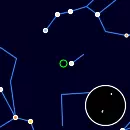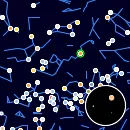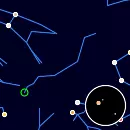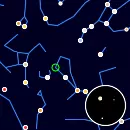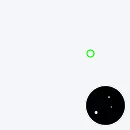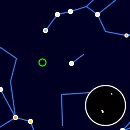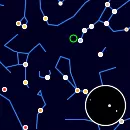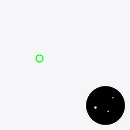Triple Star Systems Visible Tonight: Explore Complex Star Systems
Sky Map
Celectial bearing and elevation at 03:02
Triple star systems are fascinating groupings of three stars that may or may not be gravitationally bound. Some, like Alpha Centauri, include a combination of gravitationally bound stars and distant companions, while others are simply optical triples. Understanding the dynamics of these systems offers valuable insights into the processes of stellar formation and interaction.
13101+3830
Triple Star System
Triple star system in the constellation Canes Venatici with primary and secondary components of magnitudes 5.95 and 6.26, separated by 4.8 arcminutes.
10167+2325
Triple Star System
Triple star system in the constellation Leo with primary and secondary components of magnitudes 3.46 and 6.03, separated by 5.2 arcminutes.
10459+3041
Triple Star System
Triple star system in the constellation Leo Minor with primary and secondary components of magnitudes 5.34 and 7.78, separated by 3.3 arcminutes.
14242+0549
Triple Star System
Triple star system in the constellation Virgo with primary and secondary components of magnitudes 5.11 and 7.32, separated by 2.7 arcminutes.
12492+8325
Triple Star System
Triple star system in the constellation Camelopardalis with primary and secondary components of magnitudes 5.29 and 5.74, separated by 22 arcseconds.
09276-0840
Triple Star System
Triple star system in the constellation Hydra with primary and secondary components of magnitudes 1.98 and 9.70, separated by 4.8 arcminutes.
09213+3426
Triple Star System
Triple star system in the constellation Lynx with primary and secondary components of magnitudes 3.29 and 8.83, separated by 3.4 arcminutes.
15155+3319
Triple Star System
Triple star system in the constellation Bootes with primary and secondary components of magnitudes 3.56 and 7.89, separated by 2.3 arcminutes.
10306+5559
Triple Star System
Triple star system in the constellation Ursa Major with primary and secondary components of magnitudes 4.88 and 8.86, separated by 2 arcminutes.
05034+6027
Triple Star System
Triple star system in the constellation Camelopardalis with primary and secondary components of magnitudes 4.12 and 7.44, separated by 1.3 arcminute.
08595+3225
Triple Star System
Triple star system in the constellation Cancer with primary and secondary components of magnitudes 5.32 and 8.97, separated by 1.4 arcminute.
08437-0714
Triple Star System
Triple star system in the constellation Hydra with primary and secondary components of magnitudes 4.72 and 8.20, separated by 1.2 arcminute.
13470+3833
Triple Star System
Triple star system in the constellation Canes Venatici with primary and secondary components of magnitudes 5.62 and 8.91, separated by 1.2 arcminute.
14162+5122
Triple Star System
Triple star system in the constellation Bootes with primary and secondary components of magnitudes 4.76 and 7.39, separated by 37.6 arcseconds.
06467+4335
Triple Star System
Triple star system in the constellation Auriga with primary and secondary components of magnitudes 5.31 and 8.65, separated by 53 arcseconds.
14411+1344
Triple Star System
Triple star system in the constellation Bootes with primary and secondary components of magnitudes 4.46 and 4.55, separated by 1 arcsecond.
09307+3339
Triple Star System
Triple star system in the constellation Leo Minor with primary and secondary components of magnitudes 5.97 and 9.66, separated by 50 arcseconds.
14407+1625
Triple Star System
Triple star system in the constellation Bootes with primary and secondary components of magnitudes 4.88 and 5.79, separated by 7 arcseconds.
05226+7914
Triple Star System
Triple star system in the constellation Camelopardalis with primary and secondary components of magnitudes 5.14 and 9.14, separated by 37 arcseconds.
09315+6304
Triple Star System
Triple star system in the constellation Ursa Major with primary and secondary components of magnitudes 3.65 and 9.19, separated by 19.2 arcseconds.

